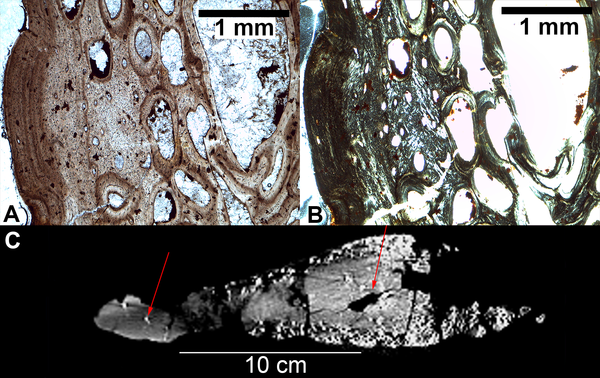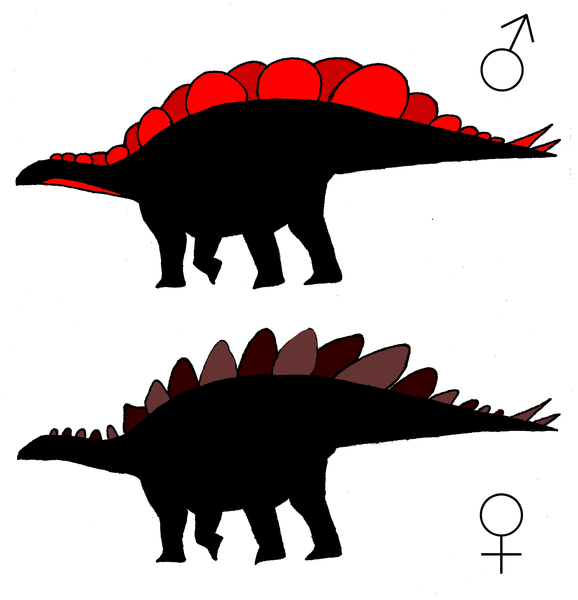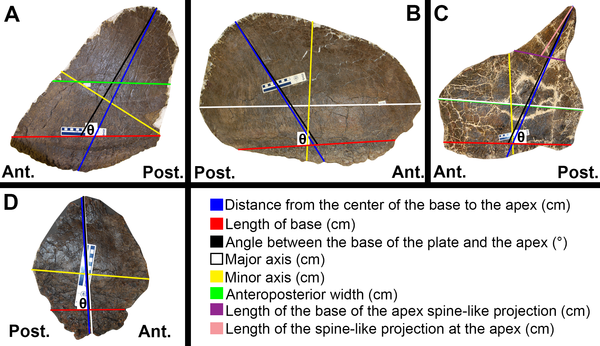Abstract
Conclusive evidence for sexual dimorphism in non-avian dinosaurs has been elusive. Here it is shown that dimorphism in the shape of the dermal plates of Stegosaurus mjosi (Upper Jurassic, western USA) does not result from non-sex-related individual, interspecific, or ontogenetic variation and is most likely a sexually dimorphic feature. One morph possessed wide, oval plates 45% larger in surface area than the tall, narrow plates of the other morph. Intermediate morphologies are lacking as principal component analysis supports marked size- and shape-based dimorphism. In contrast, many non-sex-related individual variations are expected to show intermediate morphologies. Taphonomy of a new quarry in Montana (JRDI 5ES Quarry) shows that at least five individuals were buried in a single horizon and were not brought together by water or scavenger transportation. This new site demonstrates co-existence, and possibly suggests sociality, between two morphs that only show dimorphism in their plates. Without evidence for niche partitioning, it is unlikely that the two morphs represent different species. Histology of the new specimens in combination with studies on previous specimens indicates that both morphs occur in fully-grown individuals. Therefore, the dimorphism is not a result of ontogenetic change. Furthermore, the two morphs of plates do not simply come from different positions on the back of a single individual. Plates from all positions on the body can be classified as one of the two morphs, and previously discovered, isolated specimens possess only one morph of plates. Based on the seemingly display-oriented morphology of plates, female mate choice was likely the driving evolutionary mechanism rather than male-male competition. Dinosaur ornamentation possibly served similar functions to the ornamentation of modern species. Comparisons to ornamentation involved in sexual selection of extant species, such as the horns of bovids, may be appropriate in predicting the function of some dinosaur ornamentation.

Histology of S. mjosi plates.
(A) A thin section of a tall morph plate (JRDI 5ES-357) in plane polarized light showing an external fundamental system (EFS) indicating the cessation of growth. Bone surface is to the left. (B) The same image but in crossed polarized light. (C) A CT scan of a tall morph plate (JRDI 5ES-237) in cross-section along the frontal plane. Red arrows indicate internal vascular piping that is a sign of sexual maturity.
doi:10.1371/journal.pone.0123503.g003

Hypothetical silhouettes of male and female S. mjosi.
The wide morph exhibits more overlap between adjacent plates than does the tall morph, leading to a more continuous display surface. Sexual dimorphism in the size and shape and plates might have also occurred with other sexual differences such as sexual dichromatism.
doi:10.1371/journal.pone.0123503.g004

Diagrammatic depiction of measurements.
(A) Vertical oval/triangular plates (JRDI 5ES-579). Tall morph S. mjosi plates typically fall under this category. The minor axis, rather than the anteroposterior width, was the value used for ‘width’ in PCA. (B) Horizontal oval plates (JRDI 5ES-523). Wide morph S. mjosi plates typically fall under this category. The major axis was the value used for ‘width’ in PCA. (C) Sub-right trapezoidal plates (DMNS 2818). The major axis and anteroposterior width tend to converge. The major axis was the value used for ‘width’ in PCA. (D) Shoulder plates (NHMUK R36730). These plates have a distinctive diamond shape. The distance from the center of the base to the apex and the major axis tend to converge.
doi:10.1371/journal.pone.0123503.g005
Citation: Saitta ET (2015) Evidence for Sexual Dimorphism in the Plated Dinosaur Stegosaurus mjosi (Ornithischia, Stegosauria) from the Morrison Formation (Upper Jurassic) of Western USA. PLoS ONE 10(4): e0123503. doi:10.1371/journal.pone.0123503
Academic Editor: Matjaž Kuntner, Scientific Research Centre, Slovenian Academy of Sciences and Arts, SLOVENIA



 April 23rd, 2015
April 23rd, 2015  Riffin
Riffin 
 Posted in
Posted in  Tags:
Tags: 